Fuel and Energy Complex of Kazakhstan: Geological and Economic Assessment of Enterprises in the Context of Digital Transformation
Abstract
:1. Introduction
2. Literature Review
3. Methods
4. Results and Discussion
4.1. Evaluating the Effectiveness of the Digital Transformation of the Mining Industry
4.2. Improving Geological and Economic Assessment of Enterprises
- -
- Mining asset (“YES”): a mineral asset for which a current ore reserve is declared, and mining and processing has commenced and is ongoing;
- -
- Asset under construction (“CA”): a mineral asset for which an ore reserve is declared and substantively justified at a level not lower than a preliminary feasibility study, which demonstrates on a multidisciplinary basis that the development of the asset is technically feasible and economically viable;
- -
- Detailed exploration asset (“ADR”): a mineral asset for which only mineral resources are declared;
- -
- Exploration asset (“RA”): a mineral asset for which no mineral resources have been declared.
- -
- Commissioning of new deposits, modernization of already functioning mines (in 2027, the reconstruction of the Nurkazgan mine with an increase in productivity of up to 6.5 million tons; in 2028, the achievement of annual productivity of up to 8 million tons of ore at the Zhilandinsky mine; in 2026, the construction of shafts “Ventilation-2”, “Air-supply—Cletevoy-2”, “Skipovaya” at the Nurkazgan mine).
- -
- Achieving the maximum workload of existing factories (in 2024, the increase in the annual productivity of the Karagaily concentrator to 1.9 million tons of ore; in 2027, the increase in the annual productivity of the Nurkazgan concentrator to 6.5 million tons of ore).
- -
- Bring the newly built concentrating plants to the planned capacity (in 2024, it is planned to build a new concentrating plant with an annual capacity of 1.2 to 1.5 million tons at the Shatyrkul-Zhaysanskoye field).
- -
- Tabular data coordinates of wellheads, sampling, and well inclinometry;
- -
- Geological sections along the lines of profiles at a scale of 1:1000 (Figure 6).
5. Conclusions
- The emerging digital ecosystem of Kazakhstan is dominated by the point distribution of new technologies, and the nature of their distribution is fragmented. There is no holistic approach to digital transformation as a complex undertaking. Due to the lack of a systematic approach to the development of the “digital enterprise” and the conflict between traditional approaches to work (budgeting, procurement, security) and modern agile practices, there is a lag in the transition of the mining industry from research to the implementation of viable solutions in real production conditions, subsequent scaling from the purpose of obtaining financial benefits, approaching the zero level of industrial injuries. The foregoing complicates the interpretation and evaluation of the effectiveness of technological changes. However, as Kazakhstan integrates into global digitalization trends, largely due to government regulation, mining enterprises are experiencing a consistent increase in digital competencies, accompanied by the development of digital platforms and optimization of their own infrastructure, which contributes to the development of a favorable digital environment.
- A variety of technologies being introduced will accelerate Kazakhstan’s entry into the advanced markets of global networks in the field of advanced production and will allow realizing the accumulated comparative advantages. Studies show that sustainable economic growth is determined not so much by the scale of high-tech industries and foreign exchange earnings of the state but by the growing capabilities of enterprises in various industries, coordination of joint actions of the state, business and educational structures to the constant complication of production and exports. In recent years, there has been a growing interest in Kazakhstan in studying indicators of economic complexity that predict differences in economic growth, as shown in the works of F. Neffke and M. Henning [56] and CA Hidalgo [57]. According to a study by Z. Miao [58], this can improve comparative advantages in the export of goods and make progress in the integration of the digital economy and the value chain [46].
- The study found that there are numerous barriers to the digital transformation of the mining industry in Kazakhstan, but none of them are insurmountable. Digital transformation processes should be systemic and should increase technological independence in key digital technologies, which will accelerate adaptation to a dynamic environment. The accumulated international experience and Kazakhstani practice help to summarize the challenges and realize the opportunities that digitalization opens up for the mining industry.
- The combination of economic modeling and digital technologies will provide the top management of enterprises with a software tool for long-term predictive calculations of various options for the development of deposits. Medium- and long-term ESG goals of enterprises, coordinated with the UN sustainable development goals, will allow establishing mutually beneficial contacts with stakeholders (state, society, owners, customers, suppliers, personnel), not only demonstrate the impact of an enterprise on society and the environment but also prove the existence of positive changes, in particular, the availability of financial and organizational capabilities to achieve corporate goals, including long-term guidelines in the field of ESG principles.
Author Contributions
Funding
Data Availability Statement
Conflicts of Interest
References
- Cahyadi, A.; Magda, R. Digital Leadership in the Economies of the G20 Countries: A Secondary Research. Economies 2021, 9, 32. [Google Scholar] [CrossRef]
- Trabucchi, D.; Muzellec, L.; Ronteau, S.; Buganza, T. The platforms’ DNA: Drivers of value creation in digital two-sided platforms. Technol. Anal. Strateg. Manag. 2021, 34, 891–904. [Google Scholar] [CrossRef]
- Foster, C.; Azmeh, S.H. Latecomer Economies and National Digital Policy: An Industrial Policy Perspective. J. Dev. Stud. 2019, 56, 1247–1262. [Google Scholar] [CrossRef]
- Bas, M.; Strauss-Khan, V. Does importing more inputs raise exports? Firm-level evidence from France. Rev. World Econ. 2014, 150, 241–275. [Google Scholar] [CrossRef]
- Castellani, D.; Fassio, C. From new imported inputs to new exported products. Firm-level evidence from Sweden. Res. Policy 2018, 48, 322–338. [Google Scholar] [CrossRef]
- Hsieh, P.L.; Mercurio, B. ASEAN Law in the New Regional Economic Order. Global Trends and Shifting Paradigms; Cambridge University Press: Cambridge, UK, 2019; 292p. [Google Scholar]
- Fritsch, M.; Wyrwich, M. Regional knowledge, entrepreneurial culture, and innovative start-ups over time and space—An empirical investigation. Small Bus. Econ. 2018, 51, 337–353. [Google Scholar] [CrossRef]
- Park, S.; Park, I. The value-added creation effect of industry position in global value chains: Implications for Asia-Pacific economies. Asian-Pac. Econ. Lit. 2021, 35, 95–122. [Google Scholar] [CrossRef]
- Adarkwah, G.K.; Malonæs, T.P. Firm-specific advantages: A comprehensive review with a focus on emerging markets. Asia Pac. J. Manag. 2022, 39, 539–585. [Google Scholar] [CrossRef]
- Bazaluk, O.; Ashcheulova, O.; Mamaikin, O.; Khorolskyi, A.; Lozynskyi, V.; Saik, P. Innovative Activities in the Sphere of Mining Process Management. Front. Environ. Sci. 2022, 10, 878977. [Google Scholar] [CrossRef]
- Aznar-Sánchez, J.A.; Velasco-Muñoz, J.F.; Belmonte-Ureña, L.J.; Manzano-Agugliaro, F. Innovation and Technology for Sustainable Mining Activity: A Worldwide Research Assessment. J. Clean. Prod. 2019, 221, 38–54. [Google Scholar] [CrossRef]
- Gruenhagen, J.H.; Parker, R. Factors Driving or Impeding the Diffusion and Adoption of Innovation in Mining: A Systematic Review of the Literature. Resour. Policy 2020, 65, 101540. [Google Scholar] [CrossRef]
- Kopacz, M.; Kulpa, J.; Galica, D.; Dyczko, A.; Jarosz, J. Economic Valuation of Coal Deposits—The Value of Geological Information in the Resource Recognition Process. Resour. Policy 2019, 63, 101450. [Google Scholar] [CrossRef]
- Cioacă, S.-I.; Cristache, S.-E.; Vuță, M.; Marin, E.; Vuță, M. Assessing the Impact of ICT Sector on Sustainable Development in the European Union: An Empirical Analysis Using Panel Data. Sustainability 2020, 12, 592. [Google Scholar] [CrossRef]
- Frederico, G.F. Project Management for Supply Chains 4.0: A conceptual framework proposal based on PMBOK methodology. Oper. Manag. Res. 2021, 14, 434–450. [Google Scholar] [CrossRef]
- Jovanovic, P.; Beric, I. Analysis of the available project management methodologies. Manag. J. Sustain. Bus. Manag. Solut. Emerg. Econ. 2018, 23, 1–13. [Google Scholar] [CrossRef]
- Klippel, A.F.; Petter, C.O.; Antunes, J.A.V. Management Innovation, a Way for Mining Companies to Survive in a Globalized World. Util. Policy 2008, 16, 332–333. [Google Scholar] [CrossRef]
- Kharabadze, E.; Jikia, M. Evaluation and analysis of the rational structure of sources for assets formation. Arch. Bus. Res. 2018, 6, 49–56. [Google Scholar]
- Hackbarth, D.; Mathews, R.; Robinson, D. Capital structure, product market dynamics, and the boundaries of the firm. Manag. Sci. 2014, 60, 2971–2993. [Google Scholar] [CrossRef]
- Uteshov, Y.; Galiyev, D.; Galiyev, S.; Rysbekov, K.; Nauryzbayeva, D. Potential for Increasing the Efficiency of Design Processes for Mining the Solid mineral Deposits Based on Digitalization and Advanced Analytics. Min. Miner. Depos. 2021, 15, 102–110. [Google Scholar] [CrossRef]
- Saik, P.; Petlovanyi, M.; Lozynskyi, V.; Sai, K.; Merzlikin, A. Innovative Approach to the Integrated Use of Energy Resources of Underground Coal Gasification. Solid State Phenom. 2018, 277, 221–231. [Google Scholar] [CrossRef]
- Zhironkin, S.; Cehlár, M. Coal Mining Sustainable Development: Economics and Technological Outlook. Energies 2021, 14, 5029. [Google Scholar] [CrossRef]
- Khorolskyi, A.; Hrinov, V.; Mamaikin, O.; Demchenko, Y. Models and Methods to Make Decisions while Mining Production Scheduling. Min. Miner. Depos. 2019, 13, 53–62. [Google Scholar] [CrossRef]
- Nwaila, G.T.; Frimmel, H.E.; Zhang, S.E.; Bourdeau, J.E.; Tolmay, L.C.K.; Durrheim, R.J.; Ghorbani, Y. The minerals industry in the era of digital transition: An energy-efficient and environmentally conscious approach. Resour. Policy 2022, 78, 102851. [Google Scholar] [CrossRef]
- Song, Y.; Zhang, Z.; Zhang, Y.; Cheng, J. Technological innovation and supply of critical metals: A perspective of industrial chains. Resour. Policy 2022, 79, 103144. [Google Scholar] [CrossRef]
- Miao, C.; Fang, D.; Sun, L.; Luo, Q. Natural resources utilization efficiency under the influence of green technological innovation. Resour. Conserv. Recycl. 2017, 126, 153–161. [Google Scholar] [CrossRef]
- Ericsson, M.; Drielsma, J.; Humphreys, D.; Storm, P.; Weihed, P. Why current assessments of ‘future efforts’ are no basis for establishing policies on material use-a response to research on ore grades. Miner. Econ. 2019, 32, 111–121. [Google Scholar] [CrossRef]
- Azadi, M.; Northey, S.A.; Ali, S.H.; Edraki, M. Transparency on greenhouse gas emissions from mining to enable climate change mitigation. Nat. Geosci. 2020, 13, 100–104. [Google Scholar] [CrossRef]
- Svobodova, K.; Owen, J.R.; Kemp, D.; Moudrý, V.; Lèbre, É.; Stringer, M.; Sovacool, B.K. Decarbonization, population disruption and resource inventories in the global energy transition. Nat. Commun. 2022, 13, 7674. [Google Scholar] [CrossRef]
- Shah, Z.; Zaman, K.; Khan, H.U.R.; Rashid, A. The Economic Value of Natural Resources and Its Implications for Pakistan’s Economic Growth. Commodities 2022, 1, 65–97. [Google Scholar] [CrossRef]
- Pfeiffer, S. The Vision of “Industrie 4.0” in the Making -a Case of Future Told, Tamed, and Traded. Nanoethics 2017, 11, 107–121. [Google Scholar] [CrossRef]
- Subramanian, N.; Ramanathan, R. A review of applications of Analytic Hierarchy Process in operations management. Int. J. Prod. Econ. 2012, 138, 215–241. [Google Scholar] [CrossRef]
- Hofmann, E.; Rüsch, M. Industry 4.0 and the current status as well as future prospects on logistics. Comput. Ind. 2017, 89, 23–34. [Google Scholar] [CrossRef]
- Brandmeier, M.; Zamora, I.G.C.; Nykänen, V.; Middleton, M. Boosting for Mineral Prospectivity Modeling: A New GIS Toolbox. Nat. Resour. Res. 2020, 29, 71–88. [Google Scholar] [CrossRef]
- Fu, G.; Lü, Q.; Yan, J.; Farquharson, C.G.; Qi, G.; Zhang, K.; Zhang, Y.; Wang, H.; Luo, F. 3D mineral prospectivity modeling based on machine learning: A case study of the Zhuxi tungsten deposit in northeastern Jiangxi Province, South China. Ore Geol. Rev. 2021, 131, 104010. [Google Scholar] [CrossRef]
- Official Website of the Bureau of National Statistics of the Agency for Strategic Planning and Reforms of the Republic of Kazakhstan Bureau of National Statistics. On the Use of Information and Communication Technologies at Enterprises of the Republic of Kazakhstan. 2022. Available online: https://stat.gov.kz/en/industries/business-statistics/stat-it/spreadsheets/?year=&name=40632&period=&type= (accessed on 29 September 2022).
- Galiyev, S.Z.; Dovzhenok, A.S.; Kol’ga, A.D.; Galiyev, D.A.; Uteshov, E.T. Digitalization and the potential for improving the design and planning of mining operations in open cast mining. News Natl. Acad. Sci. Repub. Kazakhstan. Ser. Geol. Technol. Sci. 2020, 1, 146–154. [Google Scholar] [CrossRef]
- Recommendations for Solving Problems Using Digital Projects (Solutions) and for Improving the Efficiency of Enterprises; Kazakhstan Center for Industry and Export “QAZINDUSTRY” JSC: Nur-Sultan, Kazakhstan, 2021; 66p. Available online: https://qazindustry.gov.kz/docs/otchety/1597139710.pdf (accessed on 10 August 2023).
- Issataeva, F.M. Development of Theoretical and Practical Aspects of the Geological and Economic Assessment of the Kusmuryn Field. Ph.D. Thesis, Karaganda State Technical University, Karaganda, Kazakhstan, 2020. 140p. [Isatayeva, Farida Muratovna. Razrabotka teoreticheskikh i prakticheskikh aspektov geologo–ekonomicheskoy otsenki mestorozhdeniya Kusmuryn. Dissertatsii na soiskaniye stepeni doktora filosofii. Karaganda, Karagandinskiy gosudarstvennyy tekhnicheskiy universitet, 2020. 140 s]. Available online: https://www.geokniga.org/bookfiles/geokniga-razrabotka-teoreticheskih-i-prakticheskih-aspektov-geologo-ekonomicheskoy-ocen.pdf (accessed on 10 August 2023).
- Aubakirova, G.M.; Isatayeva, F.M. New Approaches to the Construction of a Diversified Economy: The Experience of Kazakhstan. Stud. Russ. Econ. Dev. 2021, 32, 712–718. [Google Scholar] [CrossRef]
- Aubakirova, G.; Rudko, G.; Issatayeva, F. Assessment of metallurgical enterprises activities in Kazakhstan in the context of international trends. Econ. Ann.-XXI 2021, 187, 121–130. [Google Scholar] [CrossRef]
- Strategy2050.kz. Digitalization in the Mining Industry: Introduction of Scientific Achievements, Economic Benefits and Constraints. Available online: https://strategy2050.kz/ru/news/tsifrovizatsiya-v-gornodobyvayushchey-otrasli-vnedrenie-nauchnykh-dostizheniy-ekonomicheskiy-effekt-/ (accessed on 17 December 2021).
- Environmental Code of the Republic of Kazakhstan Republic Code Kazakhstan dated 2 January 2021. Available online: http://adilet.zan.kz/rus/docs/K2100000400 (accessed on 8 May 2022).
- National Energy Report. 2021. Available online: https://www.kazenergy.com/ru/operation/ned/2117/ (accessed on 14 November 2022).
- Approval of the Action Plan for the Implementation of the Concept for Transition of the Republic of Kazakhstan to a “Green Economy” for 2021–2030 Decree of the Government of the Republic of Kazakhstan Dated 29 July 2020 No. 479. Available online: http://adilet.zan.kz/rus/docs/P2000000479 (accessed on 12 November 2020).
- State Program “Digital Kazakhstan”. Approved Decree of the Government of the Republic of Kazakhstan Dated 12 December 2017. No. 827. Available online: http://adilet.zan.kz/rus/docs/P1700000827 (accessed on 4 December 2021).
- Code of the Republic of Kazakhstan Dated 27 December 2017 125-VI “On Subsoil and Subsoil Use” (as Amended and Supplemented as of 01/12/2023). Available online: https://online.zakon.kz/Document/?doc_id=31764592 (accessed on 1 March 2023).
- Young, A.; Rogers, P.A. Review of Digital Transformation in Mining. Min. Metall. Explor. 2019, 36, 683–699. [Google Scholar] [CrossRef]
- Lufin, M.; Soto-Díaz, J. Technology, geography, and diversification in a small mineral economy. Extr. Ind. Soc. 2022, 11, 101080. [Google Scholar] [CrossRef]
- Breul, M.; Atienza, M. Extractive industries and regional diversification: A multidimensional framework for diversification in mining regions. Extr. Ind. Soc. 2022, 11, 101125. [Google Scholar] [CrossRef]
- Joaquin Jara, J.; Lagos, G.; Tilton, J.E. Using exploration expenditures to assess the climate for mineral investment. Resour. Policy 2008, 33, 179–187. [Google Scholar] [CrossRef]
- Rawashdeh, R.A.; Campbell, G. Mineral policy in the Gulf Cooperation Council (GCC) countries: The case of Saudi Arabia. Extr. Ind. Soc. 2022, 9, 101042. [Google Scholar] [CrossRef]
- Hillson, G. Corporate Social Responsibility in the extractive industries: Experiences from developing countries. Resour. Policy 2012, 37, 131–137. [Google Scholar] [CrossRef]
- Guo, J.; Zhou, Y.; Ali, S.; Shahzad, U.; Cui, L. Exploring the role of green innovation and investment in energy for environmental quality: An empirical appraisal from provincial data of China. J. Environ. Manag. 2021, 292, 112779. [Google Scholar] [CrossRef] [PubMed]
- Menzel, T.; Teubner, T. Green Energy Platform Economics—Understanding Platformization and Sustainabilization in the Energy Sector. Int. J. Energy Sect. Manag. 2020, 15, 456–475. [Google Scholar] [CrossRef]
- Neffke, F.; Henning, M. Skill Relatedness and Firm Diversification. Strateg. Manag. J. 2013, 34, 297–316. Available online: https://www.jstor.org/stable/23362658 (accessed on 14 July 2023). [CrossRef]
- Hidalgo, C.A. Economic complexity theory and applications. Nat. Rev. Phys. 2021, 3, 92–113. [Google Scholar] [CrossRef]
- Miao, Z. Digital economy value chain: Concept, model structure, and mechanism. Appl. Econ. 2021, 53, 4342–4357. [Google Scholar] [CrossRef]
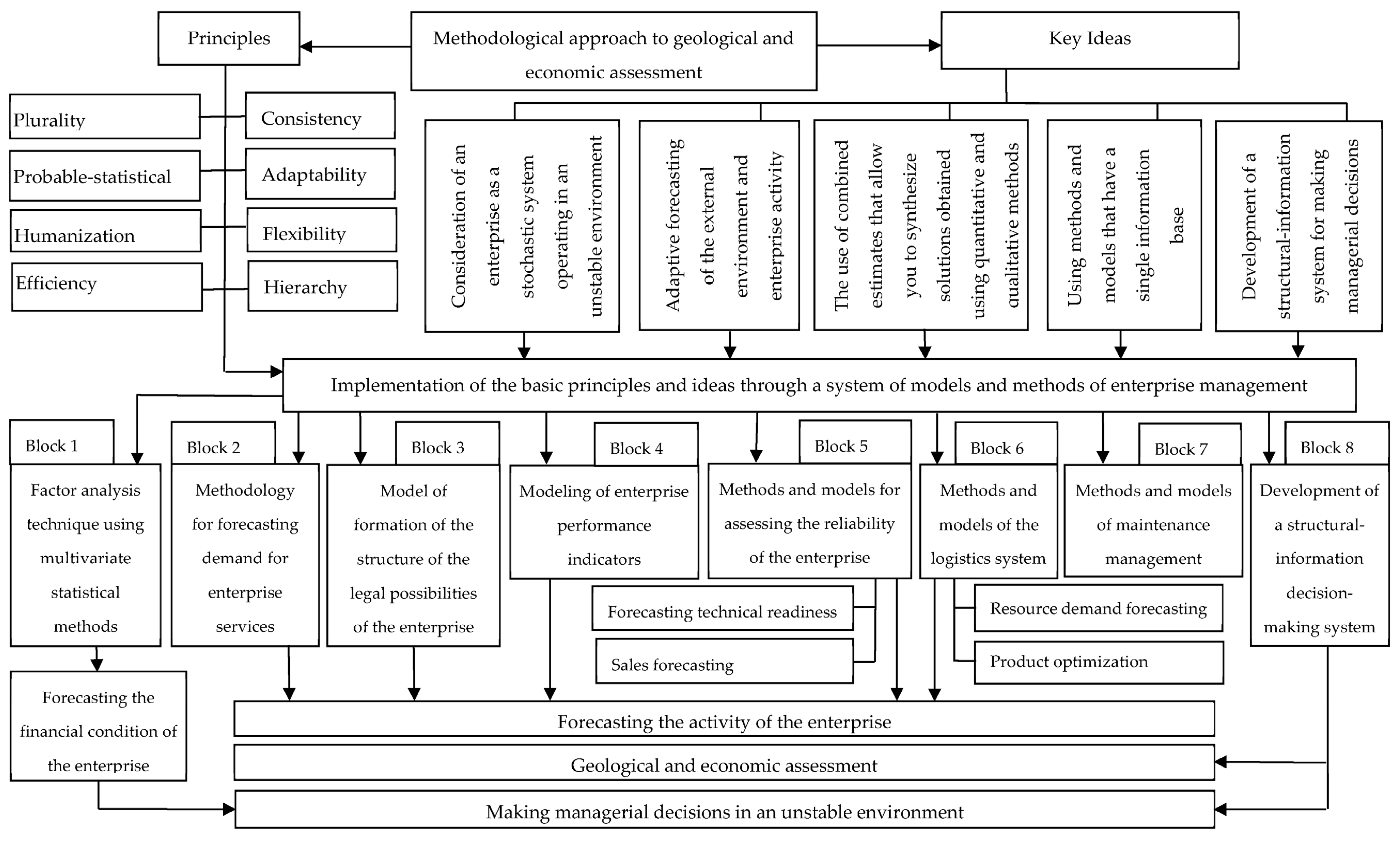
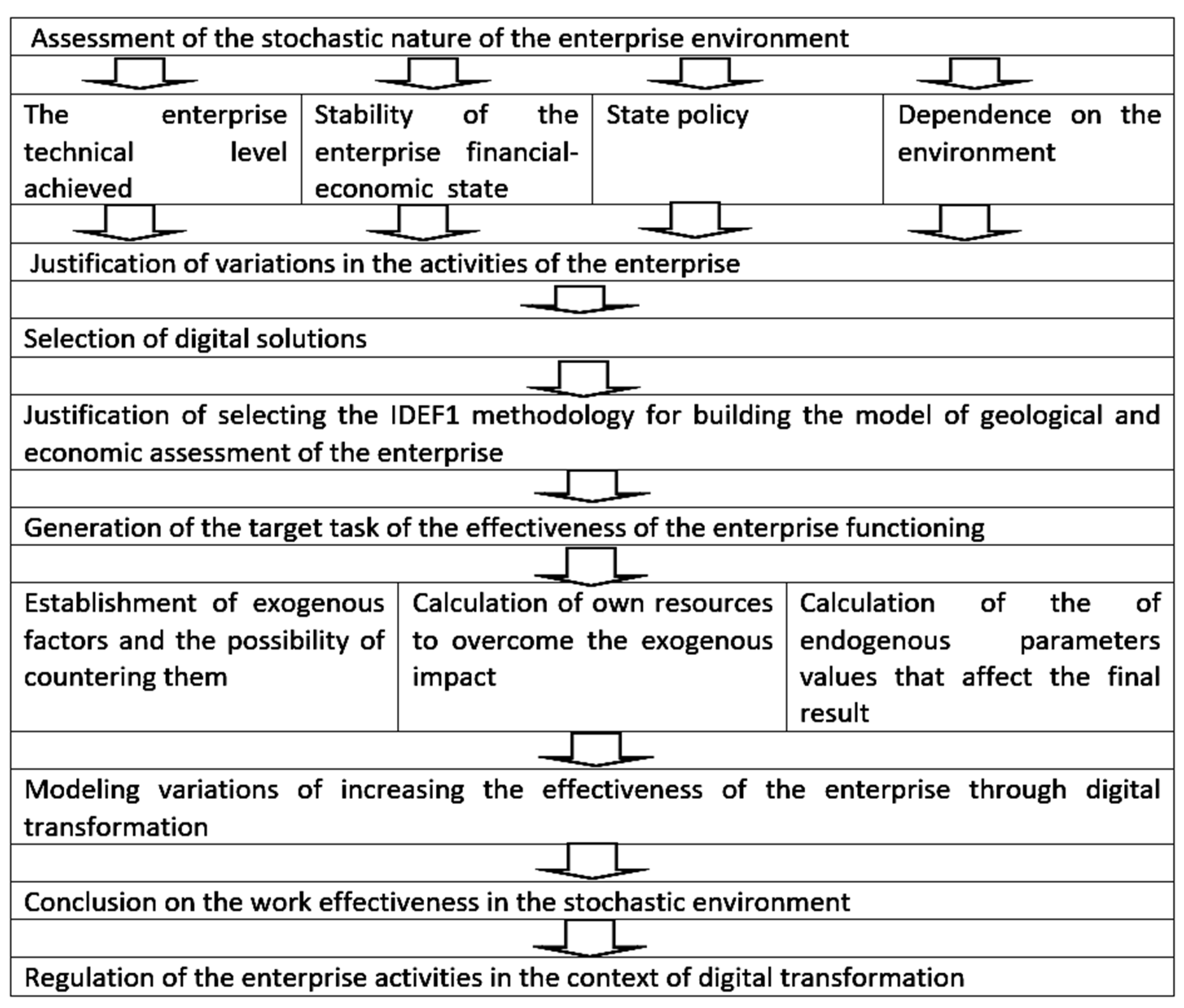

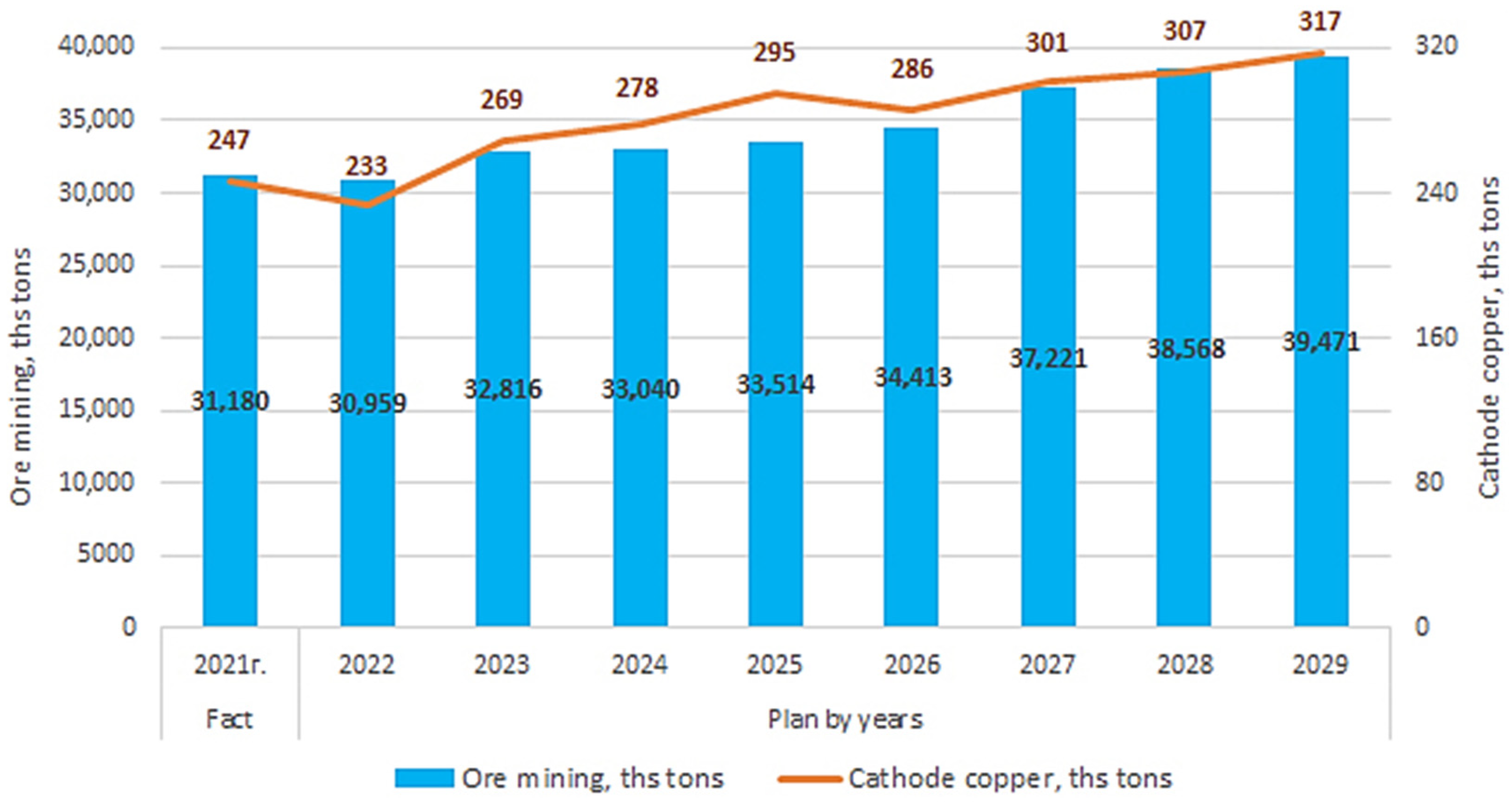
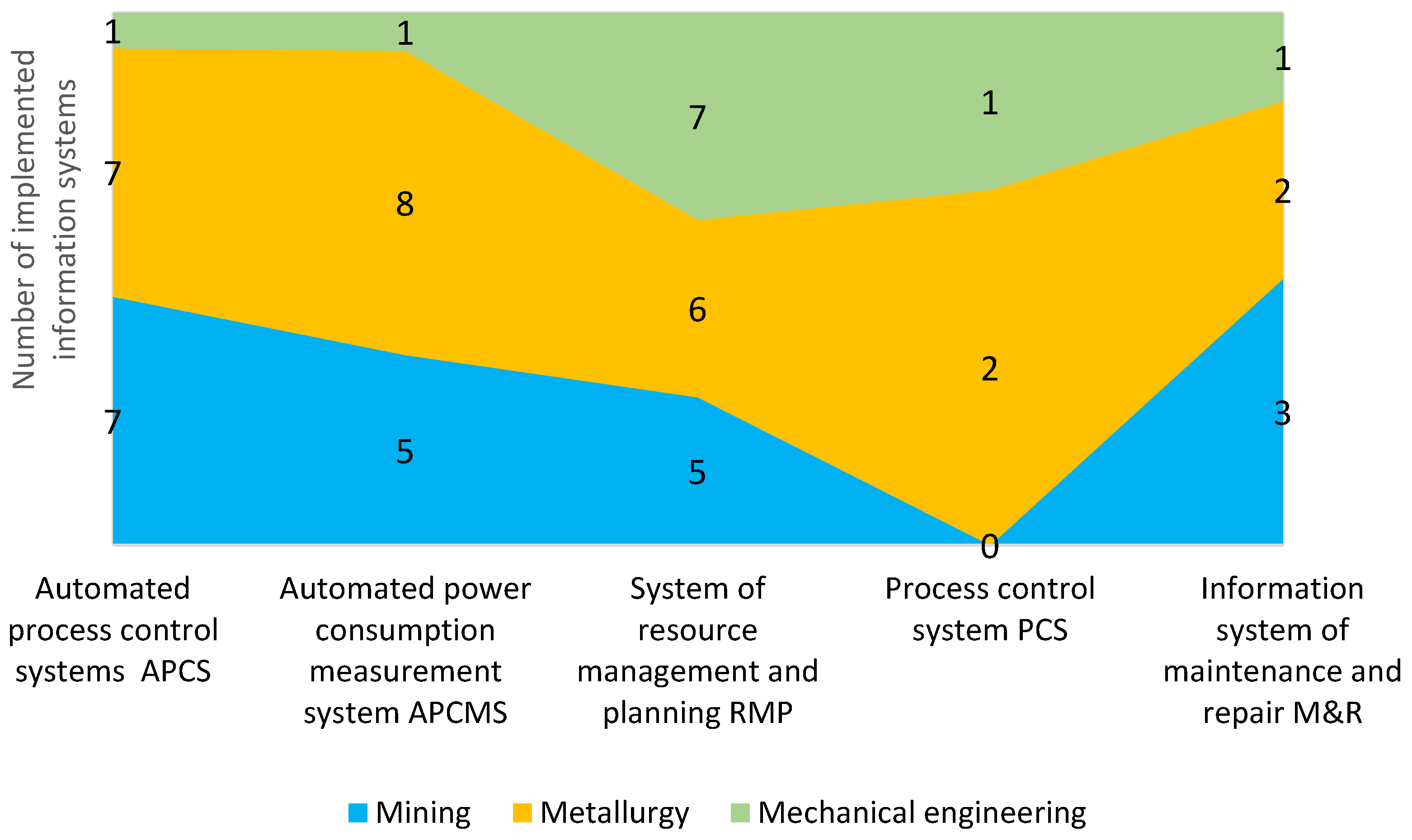
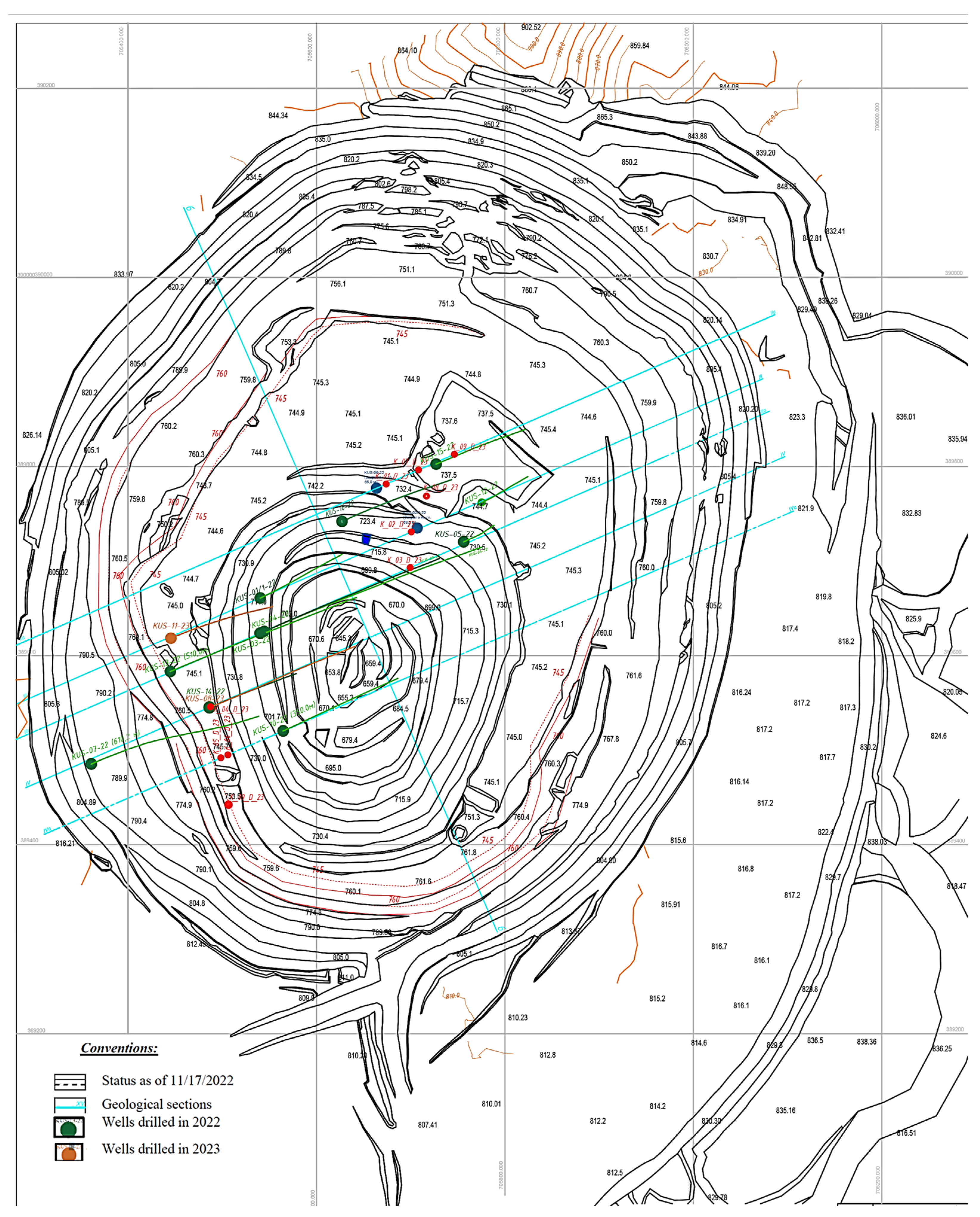
| Component A | Component B |
|---|---|
Cost components:
| Capital and operating costs associated with the additional development of new energy technologies that expand the technical potential of their use through digital transformation:
|
| Indicators | 2019 | 2020 | 2021 |
|---|---|---|---|
| The total number of enterprises surveyed of which the number of enterprises: | 1347 | 1365 | 1339 |
| 1121 | 1154 | 1111 |
| 1087 | 1124 | 1087 |
| 127 | 135 | 159 |
| 79 | 72 | 88 |
| 17 | 29 | 26 |
| The number of IT specialists | 1562 | 1377 | |
| Expenses for information and communication technologies, total million KZT | 62,926.1 | 61,516.2 | 67,742.1 |
| including: | |||
| 4899.1 | 6910.0 | 13,508.1 |
| 6489.7 | 3879.4 | 3748.1 |
| 387.2 | 312.3 | 343.7 |
| 17,321.7 | 15,744.3 | 17,609.5 |
| The number of large and medium enterprises using robotics, total | 36 | 25 | 14 |
| including: | |||
| 2 | 2 | 2 |
| 12 | 5 | 3 |
| 33 | 20 | 9 |
| The number of enterprises receiving orders for goods and services via the internet | 9 | 27 | 28 |
| The number of enterprises ordering goods and services via the internet | 84 | 73 | 67 |
| The number of businesses using social media to interact with customers and partners | 206 | 220 | 217 |
| The number of enterprises using IT technologies by type of activity: | |||
| 2127 | 571 | 523 |
| 244 | 218 | 187 |
| 138 | 146 | 139 |
| 53 | 41 | 39 |
| 4 | 7 | 14 |
| Sector | Number of Enterprises by Level of Digitalization | Barriers Preventing Digitalization | Digitalization Indicators | Implemented Systems |
|---|---|---|---|---|
| Mining | Low level—7 enterprises; Medium level—4 enterprises; Above medium level—2 enterprises | Absence of financial resources for digitalization and infrastructure, understanding of the benefits from the introduction of digitalization among the management of enterprises. Absence of qualified personnel and suppliers of digitalization solutions for the enterprise. Barriers related to insufficient cybersecurity, data confidentiality, unauthorized access to data, and data leakage. | The number of enterprises that provide for the cost of training personnel in the field of digitalization—7. The number of implemented systems/software (SW)—15. The number of enterprises where there is a service responsible for digitalization—10. The number of automated business processes—24. | Dispatch Control System (DCS); Automated System of Commercial Accounting of Energy Resources (ASCAE); Digital geological model; Computer-aided design (CAD); Computer-aided manufacturing (CAM); Computer-aided engineering (CAE); 1C—a programming language that is used in the 1C: Enterprise Program family; Automated Process Control System (APCS); System for collecting, processing, displaying and archiving information (SCADA); Additive technologies or 3D printing; Production data collection system; Maintenance and Repairs (MRO); Laboratory information management system (LIMS); ERP system; Robotic process automation (RPA)—automation of the same type of business processes through software and acceleration of tasks. |
| Mining-and-smelting | Low level—5 enterprises; Medium level—2 enterprises; Above medium level—1 enterprise | Absence of digitalization solution providers for the enterprise. Absence of understanding of the benefits of introducing digitalization. Absence of sufficient infrastructure for digitalization. Absence of qualified personnel. Absence of funds for investment in digitalization. | The number of enterprises that provide for the cost of training personnel in the field of digitalization—3. The number of implemented systems/software—11. The number of enterprises where there is a service responsible for digitalization—6. The number of automated business processes—6. | APCS; SCADA; ASCAE; LIMS; ERP; MES; DCS; MRO; Digital geological model; CAM; CAE; Artificial intelligence (AI)/machine learning (ML)—(artificial intelligence, the use of data tools and predictive analytics to obtain a quality recommendation). |
| Ore Bodies | Stocks as of 1 January 2022 | ||||||||
|---|---|---|---|---|---|---|---|---|---|
| Ore, Thousand Tons | Copper | Gold | Silver | Zinc | |||||
| % | T | g/t | kg | g/t | T | % | T | ||
| RT 1 | 1,138,159.0 | 3.43 | 39,027 | 2.19 | 2496.9 | 34.02 | 39 | 3.4 | 38,747 |
| RT 2 | 21,638,586.8 | 3.02 | 652,748 | 0.71 | 15,285.9 | 13.32 | 288 | 0.59 | 128,524 |
| RT 3 | 2,505,455.4 | 1.82 | 45,591 | 0.23 | 565.7 | 4.5 | 11 | 0.31 | 7649 |
| Lens 4 | 1,562,573.4 | 2.20 | 34,375 | 0.25 | 397.2 | 5.18 | 8 | 0.09 | 1424 |
| Total: | 26,844,774.6 | 2.87 | 771,741 | 0.70 | 18,746 | 12.90 | 346 | 0.66 | 176,344 |
| Ore Bodies | Stocks as of 1 January 2022 | ||||||||
|---|---|---|---|---|---|---|---|---|---|
| Ore, Thousand Tons | Copper | Gold | Silver | Zinc | |||||
| % | T | g/t | kg | g/t | T | % | T | ||
| RT 1 | 851,827.49 | 3.68 | 31,313.44 | 1.18 | 1008.24 | 24.33 | 20.72 | 3.29 | 28,033.32 |
| RT 2 | 23,582,652.34 | 3.03 | 714,050.12 | 0.65 | 15,343.32 | 11.51 | 271.40 | 1.39 | 327,880.74 |
| RT 3 | 2,536,577.03 | 1.68 | 42,544.42 | 0.17 | 443.14 | 5.57 | 14.13 | 0.18 | 4691.06 |
| Lens 4 | 1,784,380.59 | 1.74 | 31,125.34 | 0.20 | 363.66 | 3.57 | 6.38 | 0.06 | 1137.75 |
| Total: | 28,755,437.45 | 2.85 | 819,033.32 | 0.60 | 17,158.36 | 10.87 | 312.63 | 1.26 | 361,742.87 |
| Ore Bodies | Stocks as of 1 January 2022 | ||||||||
|---|---|---|---|---|---|---|---|---|---|
| Ore, Thousand Tons | Copper | Gold | Silver | Zinc | |||||
| % | T | g/t | kg | g/t | T | % | T | ||
| RT 1 | −286,331.5 | 0.03 | −7713 | 5.20 | −1489 | 0.06 | −18 | 37.42 | −10,714 |
| RT 2 | 1,944,065.6 | 0.03 | 61,302 | 0.03 | 57 | −0.01 | −17 | 102.55 | 199,357 |
| RT 3 | 31,121.6 | −0.10 | −3046 | −3.94 | −123 | 0.09 | 3 | −95.04 | −2958 |
| Lens 4 | 221,807.2 | −0.01 | −3250 | −0.15 | −34 | −0.01 | −2 | −1.29 | −286 |
| Total: | 1,910,662.9 | 2.48 | 47,292 | −0.83 | −1587 | −17.62 | −33.7 | 9.70 | 185,399 |
Disclaimer/Publisher’s Note: The statements, opinions and data contained in all publications are solely those of the individual author(s) and contributor(s) and not of MDPI and/or the editor(s). MDPI and/or the editor(s) disclaim responsibility for any injury to people or property resulting from any ideas, methods, instructions or products referred to in the content. |
© 2023 by the authors. Licensee MDPI, Basel, Switzerland. This article is an open access article distributed under the terms and conditions of the Creative Commons Attribution (CC BY) license (https://creativecommons.org/licenses/by/4.0/).
Share and Cite
Issatayeva, F.M.; Aubakirova, G.M.; Maussymbayeva, A.D.; Togaibayeva, L.I.; Biryukov, V.V.; Vechkinzova, E. Fuel and Energy Complex of Kazakhstan: Geological and Economic Assessment of Enterprises in the Context of Digital Transformation. Energies 2023, 16, 6002. https://doi.org/10.3390/en16166002
Issatayeva FM, Aubakirova GM, Maussymbayeva AD, Togaibayeva LI, Biryukov VV, Vechkinzova E. Fuel and Energy Complex of Kazakhstan: Geological and Economic Assessment of Enterprises in the Context of Digital Transformation. Energies. 2023; 16(16):6002. https://doi.org/10.3390/en16166002
Chicago/Turabian StyleIssatayeva, Farida M., Gulnara M. Aubakirova, Aliya D. Maussymbayeva, Lyussiya I. Togaibayeva, Valery V. Biryukov, and Elena Vechkinzova. 2023. "Fuel and Energy Complex of Kazakhstan: Geological and Economic Assessment of Enterprises in the Context of Digital Transformation" Energies 16, no. 16: 6002. https://doi.org/10.3390/en16166002
APA StyleIssatayeva, F. M., Aubakirova, G. M., Maussymbayeva, A. D., Togaibayeva, L. I., Biryukov, V. V., & Vechkinzova, E. (2023). Fuel and Energy Complex of Kazakhstan: Geological and Economic Assessment of Enterprises in the Context of Digital Transformation. Energies, 16(16), 6002. https://doi.org/10.3390/en16166002







